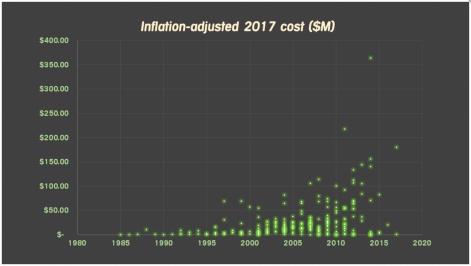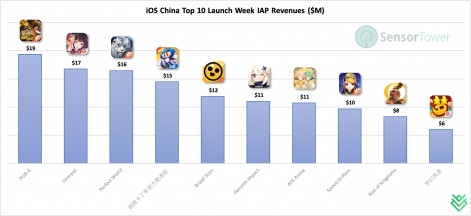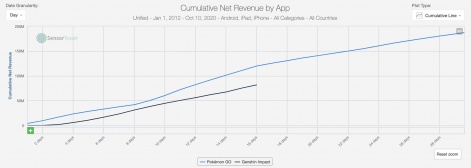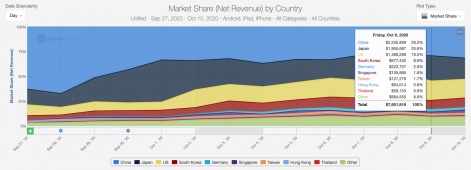Master the Meta is a free newsletter focused on analysing the business strategy of the gaming industry. MTM and PG.biz have partnered on a weekly column to not only bring you industry moving news, but also short analyses on each. To check out this week’s entire meta, visit www.masterthemeta.com!
On September 28th, Genshin Impact made headlines across the industry. Not only did it break international launch records for a China-developed game, but it also grossed more than China’s TikTok on launch day and captured more Twitch viewership than Fortnite at the same time!
Further, it’s available across PC, PS4, and mobile, enables cross-play, and a Nintendo Switch version is in the works. The game is developed by miHoYo, a Shanghai-based studio best known for producing high quality F2P mobile titles (like Honkai Impact 3rd, which, according to Sensor Tower, grossed ~$500M over its lifetime, not including China Android).
While all the vanity metrics above partially show why Genshin Impact is significant, let’s peel back three more layers. Before we dive in, enjoy the game trailer.
Great game!
First – Genshin Impact is simply a great gaming experience! Heavily inspired from The Legend of Zelda: Breath of the Wild (BoTW), the game is a beautiful, narrative-driven, open-world action-RPG with free-to-play (F2P) gacha (aka loot boxes) monetisation mechanics.
Progression is driven through a flurry of main storyline quests and side-quests, and players have to level up various aspects of their character roster to keep traversing content. The take on the elemental-based combat system is probably the biggest difference to BoTW, and working toward mastering the unique fighting abilities of various characters is quite fun.
Importantly, long-term player retention and revenue is driven by being able to acquire the rarest characters from the gacha and work towards maxing their stats out. The current character roster is about two dozen strong, which feels low in terms of depth for a gacha-driven game; however, a wide array of character upgrade options, weapons, artifacts, and other materials help bolster the gacha depth. Also, miHoYo will certainly add new characters to the gacha over time.
Further, the game’s characters and world are stunningly detailed with a high-quality cell-shaded art style that miHoYo seems to have perfected with Honkai Impact 3rd. And finally, the game’s soundtrack is exceptional. Under the leadership of miHoYo’s own Yu-Peng Chen, the soundtrack was recorded by the Shanghai Symphony Orchestra and the London Philharmonic Orchestra, which also did the music for the Lord of the Rings trilogy. This video is pretty exciting!
Genshin Impact truly feels like playing a console title on your mobile phone, except the vast content the game has to offer is free. I (Manyu, here) am still early into the game (Adventure Rank 10), and in the process of forming deeper design thoughts around the game’s UX, narrative, questing, character progression systems and long-term gacha revenue potential. But what I can say for now is that Genshin Impact leaves a strong first impression across platforms, which is reflected in the revenue numbers highlighted below.
Bold vision
Second point – miHoYo has a bold vision for Genshin Impact. miHoYo was founded in 2012 by three students who shared a passion for technology and the Japanese ACG (Anime, Comics, Games) culture. The company’s most successful game to date, Honkai Impact 3rd, was built with the core vision of creating the best Anime inspired action-RPG for the mobile gaming market, and the game is representative of the high production quality bar miHoYo sets for its titles.
With Genshin Impact, miHoYo clearly wanted to go even bigger. The game was built with cross-platform play in mind from day one and is built on Unity (a testament to the game engine’s cross-platform abilities). Over 300 people worked on the game over a 4 year period, and the total development and marketing budget is pegged at over $100M, in the range of other high-budget AAA console titles.

Given the long development timeline and massive costs, miHoYo is placing a huge bet on the F2P business model to recoup their investment. Fortunately, the initial numbers look promising. Genshin Impact’s launch week revenues on iOS rival many other major Chinese launches over the past couple of years. If one adds revenues from China Android, the launch numbers look even better.

From a global mobile revenue perspective, Genshin Impact should be compared to Pokemon Go’s launch trajectory. According to Sensor Tower, the game’s global mobile revenues across iOS and Android (likely including China Android) grossed up to $60M during launch week.
Not only does that mean miHoYo grossed 60 per cent of its investment in 7 days just on mobile, but adding in global revenues from other platforms and netting everything out means the recoup percentage looks pretty sweet. And just today, it was announced that the game has grossed $100M, equalling its initial development and marketing budget!

That said, the cross-platform functionality has some problems. Getting cross-play to work is a headache, which means carrying progress over from device to device isn’t simple. I’m not sure whether others feel similarly, but if yes, the game drops the ball on this aspect of its cross-play value proposition.
Further, the general gaming community doesn’t seem to be too impressed with the game’s performance on mobile devices, which indicates performance optimisation issues. Lastly, there seem to be minor UX problems when playing on mobile, specifically when it comes to recreating a control system that works across device platforms.
All that said, it’s still safe to say that miHoYo’s grand vision is coming to fruition, and they’re going to be more than happy with the long-term ROI on this game. That leads to the…
Chinese developer trends in the top-grossing charts
Third point – miHoYo’s design and technical prowess signals a trend we have been seeing hints of the past couple of years. This trend is the rise of a new generation of Chinese game developers who are able to create fun, breakout hits for global audiences. An ACG themed action-RPG like this one would’ve usually generated >70 per cent of its revenues only from China. But Genshin Impact is seeing a healthy mobile revenue split across all territories with US contributing ~20 per cent and the rest of the world contributing ~25 per cent:

This trend is even more pronounced when looking at some other recent top grossing games. AFK Arena from Lilith Games is the gold standard when it comes to Idle RPGs. Rise of Kingdoms (also from Lilith Games) helped evolve what a 4X game is today.
Matchington Mansion from Firecraft Studios surprised the entire Puzzle market by being able to compete with the likes of Playrix’s Homescapes and Gardenscapes. Archero from Habby showed the industry how to evolve hypercasual to its next stage – hybridcasual.
And finally, Arknights from Hypergryph was a breakout hit while massively refreshing the tower defense RPG sub-genre. Not only are all these games top-grossing titles in the west, but some can also be called genre-defining. More importantly, western developers are learning from these China-developed games and rewriting mobile F2P game design best practices. In a nutshell, China is turning the tables on the west.
Genshin Impact is a huge leap forward in that race and should be celebrated by the Chinese game development community (and be a wake-up call for Western developers). It’s a brilliant, original IP product that has managed to capture the hearts (and wallets!) of global gaming audiences across PC, console, and mobile platforms. miHoYo’s daring vision is great, but it still has a long road ahead since this massive game with an enormous content pipeline needs to be live operated.
From a higher level Chinese developer standpoint, it feels like making games that also resonate with the western markets has been a challenge for a long time. Yes, significant geopolitical headwinds may continue to emerge, but it seems like miHoYo and Chinese game developers are well on their way to create new normals within the industry. And with Genshin Impact in the rear view mirror, Chinese game developer visions are only going to get bigger!
Additionally, we’re conducting a full game deconstruction, which we’ll post to our website and send out to our subscribers soon. Make sure to subscribe to Master the Meta for updates. We’d also recommend checking out these design thoughts, which also helped inspire some of the strategy thoughts we discuss above.
Master the Meta is a newsletter focused on analysing the business strategy of the gaming industry.It is run by Aaron Bush and Abhimanyu Kumar. To receive future editions in your inbox sign up here:

